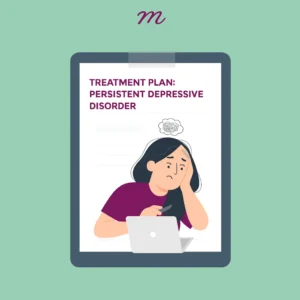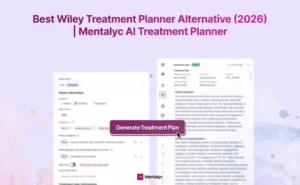Eye Movement Desensitization and Reprocessing (EMDR) emerged as a powerful and evidence-based therapeutic approach for trauma resolution and various other mental health conditions. Developed by Dr. Francine Shapiro in the late 1980s, EMDR gained recognition and acclaim within the mental health field because of its remarkable effectiveness in treating post-traumatic stress disorder (PTSD), anxiety disorders, phobias, and depression (Shapiro, 2017).
EMDR treatment plans play a pivotal role in guiding psychotherapists and clients through the healing and recovery process. By providing structure, clarity, and measurable outcomes, treatment plans offer a roadmap for therapy, ensuring that both therapists and clients have a clear understanding of therapeutic goals and objectives. EMDR treatment plans allow therapists to systematically address the client’s presenting concerns while adhering to the established protocol and principles of EMDR therapy.
This article explores key elements of an EMDR treatment plan, emphasizing the significance of setting treatment goals and objectives. We will explore the process of collaboratively establishing goals with clients, identifying specific target issues, and developing measurable treatment objectives. Additionally, we will provide valuable insights and practical strategies for psychotherapists to create an effective and individualized roadmap for their clients, ensuring that each treatment plan is tailored to meet the unique needs and circumstances of the individual client.
Understanding EMDR
It is essential for psychotherapists to have a solid understanding of the underlying principles and methodology of EMDR therapy in order to create appropriate goals and objectives. EMDR integrates elements of cognitive-behavioral therapy (CBT), psychodynamic therapy, and bilateral stimulation techniques, making it a versatile and comprehensive approach to healing trauma and related symptoms (Shapiro, 2017). By incorporating these complimentary therapeutic modalities, EMDR enables clients to process distressing memories, reframe maladaptive beliefs, and access their inherent capacity for resilience and growth.
At its core, EMDR aims to help clients reprocess distressing memories and experiences that contribute to their current emotional and psychological difficulties (Shapiro, 2017). Traumatic events can have a profound and lasting impact on individuals, creating deep-seated emotional wounds and disrupting their ability to function and find meaning in their lives. EMDR recognizes that traumatic experiences can become “stuck” in the brain’s information processing system, leading to the persistence of distressing symptoms and maladaptive beliefs.
The bilateral stimulation techniques used in EMDR, such as eye movements, hand taps, or auditory tones, play a crucial role in facilitating the reprocessing of traumatic memories (Shapiro, 2017). These bilateral stimulations activate both hemispheres of the brain, mirroring the natural mechanism of rapid eye movement (REM) sleep, which is believed to facilitate the processing and integration of emotional experiences. By engaging in bilateral stimulation during the therapeutic process, clients can effectively access and reprocess traumatic memories, leading to their resolution and the alleviation of associated distress.
One of the key principles of EMDR is adaptive information processing (Solomon & Shapiro, 2008). This concept posits that individuals have an inherent capacity for healing and growth, but traumatic experiences can disrupt this natural process. EMDR aims to restore the adaptive information processing system by enabling clients to access their inner resources and integrate positive beliefs and insights. Through the systematic reprocessing of distressing memories, clients can experience a shift in their emotional and cognitive responses, allowing for the development of healthier perspectives and improved overall well-being.
Another fundamental aspect of EMDR is the recognition of the mind-body connection. Traumatic experiences often manifest in both emotional and physiological symptoms, leading to a complex interplay between thoughts, beliefs, emotions, and body sensations. EMDR acknowledges and addresses this interconnectedness, facilitating the resolution of distressing emotions, cognitions, and physical sensations associated with trauma. By attending to the mind-body connection, EMDR helps clients achieve a comprehensive healing experience that integrates their emotional, cognitive, and somatic aspects.
Note that EMDR is not solely limited to trauma treatment. While its origins lie in addressing trauma-related disorders, EMDR has demonstrated efficacy in treating a broad spectrum of mental health conditions, including anxiety disorders, depression, phobias, grief, and more (Davidson & Parker, 2001). The adaptive nature of EMDR allows it to be tailored to the specific needs of each client, making it a versatile therapeutic approach that can be applied across diverse populations and clinical presentations.
By understanding the principles and methodology of EMDR, psychotherapists can appreciate the depth and effectiveness of this approach. EMDR’s integration of various therapeutic modalities focuses on adaptive information processing, and recognition of the mind-body connection provides a comprehensive framework for facilitating healing, growth, and resilience in individuals affected by trauma and other mental health conditions. With this understanding, therapists can approach the development of an EMDR treatment plan with confidence, ensuring they can harness the full potential of EMDR therapy to support their clients’ transformative journeys.
Developing a Treatment Plan
The process of developing an EMDR treatment plan starts with building a strong therapeutic alliance and conducting a comprehensive assessment. Through collaboration and a deep understanding of the client’s history, trauma experiences, and current symptoms, psychotherapists gain valuable insights into the client’s unique needs and treatment priorities. This information serves as the foundation for establishing meaningful treatment goals and objectives that thoroughly address the client’s concerns.
Throughout the course of therapy, therapists guide clients through the eight-phase protocol of EMDR, working systematically to desensitize and reprocess distressing memories and experiences. This process enables clients to gain a new perspective on their traumatic events, integrate adaptive insights, and cultivate a sense of empowerment and resolution. By incorporating specific treatment objectives within each phase, therapists facilitate progress, measure outcomes, and provide clients with a clear sense of direction and purpose.
Monitoring progress and regularly assessing the effectiveness of the treatment plan are critical components of successful EMDR therapy. By using outcome measures, clinical observations, and ongoing feedback from clients, therapists can gauge the impact of therapy and make necessary adjustments to optimize the treatment plan. This collaborative approach ensures that treatment remains dynamic and responsive to the client’s evolving needs and progress.
By exploring the key elements of an EMDR treatment plan and offering valuable insights, this comprehensive guide aims to equip psychotherapists with the knowledge and tools necessary to create effective and individualized roadmaps for their clients. With this understanding, therapists can confidently apply EMDR therapy, harnessing its transformative potential to help clients enhance their emotional well-being and reclaim their lives.
Establishing Treatment Goals
1. Collaboration and Assessment.
• Building Rapport – Establish a strong therapeutic alliance with the client to create a safe and supportive environment for the EMDR process.
• Psychoeducation – Provide the client with a clear understanding of EMDR, including its phases and potential outcomes. Address any concerns or questions related to EMDR to enhance the client’s engagement and commitment to the process.
• Assessment – Conduct a comprehensive evaluation of the client’s trauma history, current symptoms, and areas of distress. Identify relevant traumatic memories and other issues that will be targeted during EMDR.
2. Identifying EMDR Treatment Goals.
• Collaborative Goal Setting – Work collaboratively with the client to establish specific and measurable treatment goals for EMDR. These goals should be related to reducing the emotional distress associated with traumatic memories and improving overall mental well-being.
• Trauma Target Identification – Identify and prioritize specific traumatic memories, distressing experiences, or related symptoms that will be the focus of EMDR treatment.
• Addressing Present Triggers – Identify current triggers or situations that evoke trauma-related responses and incorporate them into the EMDR treatment plan.
3. Preparation.
• Stabilization and Coping Skills – Teach the client grounding and relaxation techniques to ensure emotional stability during EMDR processing. Equip the client with effective coping skills to manage any emotional distress that may arise during and after treatment.
• Resource Development – Help the client identify and strengthen internal resources, positive memories, and supportive relationships that can enhance their sense of resilience and self-efficacy.
4. Processing Traumatic Memories.
• Desensitization Phase – Use bilateral stimulation (e.g., eye movements, taps, or sounds) to facilitate the processing of traumatic memories. Reduce the emotional charge associated with these memories and promote adaptive integration of information.
• Installation Phase – Enhance positive beliefs, self-worth, and adaptive cognitions to replace negative beliefs and emotions related to the traumatic memories. Promote the internalization of positive resources and coping strategies.
• Body Scan – Address any residual physical sensations or emotions associated with the traumatic memories to promote a more integrated and less distressing experience.
5. Closure and Reevaluation.
• Ensure the client is in a stable and grounded state before concluding each EMDR session.
• Provide strategies for self-care and emotional regulation between sessions.
• Periodically review the progress made toward the treatment goals. Adjust the treatment plan as needed based on changes in the client’s symptoms and functioning.
6. Integration and Follow-Up.
• Help the client integrate the insights and changes experienced during EMDR processing into their daily life.
• Encourage the application of new coping skills and positive beliefs in various situations.
• Offer opportunities for follow-up sessions to monitor the maintenance of therapeutic gains achieved through EMDR. Address any remaining issues and provide additional support as necessary.
Remember that the treatment plan should be tailored to the individual client’s specific needs and goals. EMDR is a specialized therapeutic approach, and its implementation requires appropriate training and expertise. Qualified mental health professionals should conduct EMDR treatments to ensure effective and safe application.
Developing Treatment Objectives
1. Emotional Regulation.
• Skill Development – Help the client acquire effective emotion regulation techniques, such as grounding exercises, mindfulness practices, and relaxation methods. These skills empower the client to manage overwhelming emotions and maintain emotional stability both during and outside of EMDR sessions.
• Emotional Expression – Encourage the client to identify and express their emotions in a healthy and adaptive manner. This involves creating a safe space for the client to explore and process their feelings, fostering emotional awareness and understanding.
2. Cognitive Restructuring.
• Challenging Maladaptive Beliefs – Assist the client in recognizing and challenging maladaptive beliefs, self-perceptions, and cognitive distortions associated with the target issues. Through guided exploration, the client can gain insight into how these thoughts contribute to distress and work on reframing them.
• Developing Adaptive Cognitions – Encourage the development of more adaptive and realistic cognitions and self-statements. By promoting positive and balanced thinking, the client can cultivate a healthier outlook on themselves and their experiences.
3. Resourcing.
• Strengthening Internal Resources – Help the client identify and strengthen internal resources, such as personal strengths, positive memories, and coping abilities. These resources will serve as a foundation of support and stabilization during the potentially intense reprocessing phase of EMDR.
• Creating a Safe Internal Space – Foster the client’s ability to access feelings of safety, calmness, and self-soothing. This process involves developing an internal safe place that the client can utilize during difficult moments or when distress arises.
4. Trauma Processing.
• Facilitating Reprocessing – Guide the client through the 8-phase EMDR protocol to facilitate the reprocessing of traumatic memories and experiences. This process aims to desensitize the distressing emotions, beliefs, and body sensations associated with the target issues.
• Integrating Adaptive Insights – Assist the client in integrating adaptive insights and positive beliefs during the reprocessing phase. By fostering cognitive and emotional integration, the client can experience a sense of resolution and transformation related to the targeted traumas.
5. Integration and Closure.
• Consolidating Changes – Facilitate the integration of the reprocessed material into the client’s overall sense of self and life narrative. This involves helping the client make connections between past traumas and their present experiences, enabling them to create a cohesive and more positive self-identity.
• Generalization of Skills – Support the client in generalizing the changes achieved during EMDR to their daily life. Encourage the application of newly acquired coping skills and adaptive beliefs to various real-life situations.
• Session Closure – Ensure appropriate closure of each EMDR session by helping the client feel grounded, safe, and emotionally regulated before concluding. This step helps the client transition back to their everyday life in a stable and composed manner.
Throughout the EMDR treatment process, the therapist should remain sensitive to the client’s needs and progress, adjusting the objectives as necessary to ensure the most effective and personalized treatment experience.
Other Helpful Tools
In the digital age, mental health professionals can access and use tools to help them create treatment plan goals and objectives. Some therapists use tools like Wiley Treatment Planners, which saves them time and provides guidance on choosing the most effective, researched-based treatment options.
Psychotherapists can also use generative AI tools such as Mentalyc, which saves them a significant amount of time. Mentalyc allows therapists to record sessions and transcribe therapy progress notes in less than two minutes – increasing accuracy and efficiency while providing details clinicians might otherwise miss. Therapists may try this tool by signing up for Mentalyc here.
Final Thoughts
Developing a treatment plan with appropriate goals and objectives is essential for providing effective EMDR therapy. By collaboratively establishing treatment goals, identifying target issues, and formulating specific treatment objectives, psychotherapists can create a roadmap for clients’ healing and recovery. With this comprehensive guide, psychotherapists can confidently utilize EMDR therapy while tailoring treatment plans to meet the unique needs of each client, fostering transformative change and healing.
References:
- Davidson, P.R., & Parker, K.C.H. (2001). Eye movement desensitization and reprocessing (EMDR): A meta-analysis. Journal of Consulting and Clinical Psychology, 69, 305-316.
- Shapiro, F. (2017). Eye Movement Desensitization and Reprocessing (EMDR) Therapy, Third Edition: Basic Principles, Protocols, and Procedures. The Guilford Press.
- Solomon, R. M., & Shapiro, F. (2008). EMDR and the adaptive information processing model: Potential mechanisms of change. Journal of EMDR Practice and Research, 2(4), 315–325.
Disclaimer
All examples of mental health documentation are fictional and for informational purposes only.
Why other mental health professionals love Mentalyc

“It immediately changed my quality of life, personally and professionally.”
Owner/Independently Licensed Marriage & Family Therapist (LMFT)

“For anyone hesitant: this is a lifesaver. It will change your life, and you have more time to be present with your patients.”
Licensed Clinical Social Worker

“If I were recommending this software to a colleague, I would tell them that it is the best thing that they could do for their practice.”
Licensed Professional Counselor

“Do yourself a favor, make your life easier. I found Mentalyc to be one of the best tools that I’ve ever used.”
Licensed Marriage and Family Therapist







